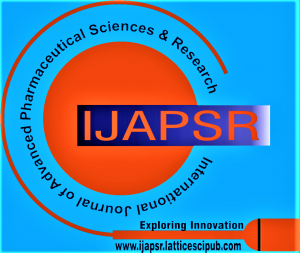![]()
Potentials of Polymeric Nanocarriers Loaded with Clarithromycin for Antibacterial Activity
Shivendra Misra1, Vivekanand Prajapati2, N T Pramathesh Mishra3
1Shivendra Misra, Department of Pharmacy, Hygia College of Pharmacy, Dr. A. P. J. Abdul Kalam Technical University, Lucknow. (Utter Pradesh), India.
2Vivekanand Prajapati, Department of Pharmacy, Hygia College of Pharmacy, Dr. A. P. J. Abdul Kalam Technical University, Lucknow. (Utter Pradesh), India.
3Dr. N T Pramathesh Mishra, Department of Pharmacy, Hygia College of Pharmacy, Dr. A. P. J. Abdul Kalam Technical University, Lucknow. (Utter Pradesh), India.
Manuscript received on 08 December 2022 | Revised Manuscript received on 13 December 2022 | Manuscript Accepted on 15 December 2022 | Manuscript published on 30 December 2022 | PP: 1-4 | Volume-3 Issue-1, December 2022 | Retrieval Number: 100.1/ijapsr. B4014023223 | DOI: 10.54105/ijapsr.B4014.123122
Open Access | Editorial and Publishing Policies | Cite | Mendeley | Indexing and Abstracting
© The Authors. Published by Lattice Science Publication (LSP). This is an open-access article under the CC-BY-NC-ND license (http://creativecommons.org/licenses/by-nc-nd/4.0/)
Abstract: Clarithromycin (CTM) is a semisynthetic derivative of erythromycin that have been reported to exhibit potential antibiotic activities mostly against the gram-negative and gram-positive bacteria, lower/upper respiratory tract and skin infection causing pathogens. It is widely used for the prevention and management of infections due to Mycobacterium avium complexes and peptic ulcers due to Helicobacter pylori. Various marketed formulation of CTM in the form of tablets, capsules and other conventional dosage forms is available as anti-infective, however the drug itself has several limitations. These limitations include low oral bioavailability, rapid metabolism, poor targeting to infected sites and toxicity to normal cells/tissues. Also, the CTM-based therapy has been reported for several gastrointestinal adverse effects, including diarrhea, stomach upset, gastric distress, atypical taste, and others. Thus, to overcome these issue, various novel strategies including nanotechnology or nanocarrier-based approaches have showed significant effects and have been immensely considered worldwide. In recent years, the various nanocarriers or nanocarrier-based delivery systems, particularly the polymeric nanocarrier have played significant role in effective drug targeting. Thus, in this review, the various polymeric nanocarrier-based delivery systems of CTM that effective reduced the dosing frequency, improved the patient compliance and potentially enhanced the therapeutic efficiency of CTM has been summarized.
Keywords: CTM, Nanotechnology, Polymeric, Atypical Taste, Including Diarrhea, Stomach Upset,
Scope of the Article: Pharmaceutics
